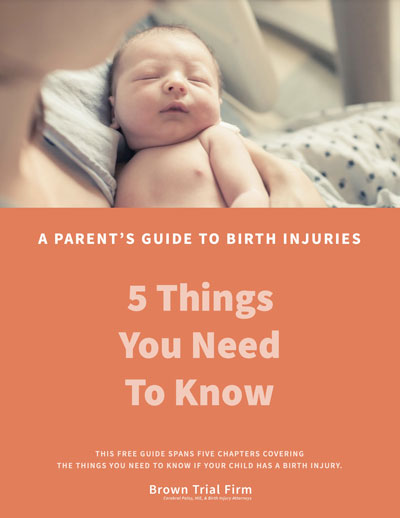5 Things You Need To Know
This Free Guide Spans Five Chapters Covering The Things You Need To Know If Your Child Has A Birth Injury.
Table of Contents
- Introduction
- About The Brown Trial Firm
- 2 Things Every Parent Should Know About Birth Injuries
- What Are the Common Causes of Birth Injuries?
- What Should I Do Next?
- Need Immediate Help?
- Signs of a Birth Injury
- The Importance of Early Treatment Intervention
- Community Support
- Legal and Financial Support
Introduction
Our mission at the Brown Trial Firm is to connect you with the resources, community support, and financial support that you need to deal with a birth injury.
All parents wish the best for a new baby. We hope, we pray, we change and adapt our own lifestyles to best prepare for the baby, and we put our trust in the medical system to do the right things to protect the baby.
Tragically, some babies are injured and some of those injuries were preventable. Birth injuries may be caused by medical negligence. If your baby was injured and you have questions, we can help you get answers.
In This Guide We Will Cover:
- The 2 Things Every Parent Should Know About Birth Injuries
- The Most Common PREVENTABLE Medical Mistakes That Cause Birth Injuries
- The Signs To Look For Of a Birth Injury
- The Importance Of Early Treatment Intervention
- How To Get The Legal And Financial Support You Need
About The Brown Trial Firm
The Brown Trial Firm is dedicated to helping families and children affected by Cerebral Palsy, HIE, and other Birth Injuries.
Every child deserves the best chance in life. Every parent deserves the support they need to help their child succeed.
Laura Brown
Laura is Board Certified in Personal Injury Trial Law by the Texas Board of Legal Specialization. She is also a Super Lawyer, a Multi-Million Dollar Advocate’s Forum member, a Top 100 Trial Lawyer by the National Trial Lawyer, the American Board of Trial Advocates Chapter President Elect, and the Birth Trauma Litigation Group Co-chair & Executive Board Member.
Providing Compassionate Legal Support
A mother of two, Laura has a passion for representing children who have been injured and their families. Her dedication and zealous advocacy has led to many successful recoveries on behalf of the families she has represented.
Recently, she obtained a $10.3 Million Dollar Verdict in a birth injury case in Texas. The baby’s umbilical cord wrapped around his neck, cutting off his supply of oxygen. The medical providers did not recognize the warning signs that the baby wasn’t getting enough oxygen. The delay in ordering a c-section delivery caused permanent damage, hypoxicischemic encephalopathy (“HIE”), and cerebral palsy.
Laura Brown
Partner, Brown Trial Firm
2 Things Every Parent Should Know About Birth Injuries
2 Things Every Parent Should Know About Birth Injuries
When a parent first learns that their child has a birth injury, there are often two pressing questions that come to mind:
1. How Did the Birth Injury Happen?
2. What Should I Do Next?
In this chapter, we’ll discuss the common causes of birth injuries and whether some birth injuries are preventable. This information was compiled from medical journals, non profits, and experts who study birth injuries. Keep reading to learn more about the two things every parent should know about birth injuries.
What Are the Common Causes of Birth Injuries?
Hospitals, nursing staff, and doctors are medical professionals who are required to follow standards of care. Standards of care exist to ensure that patients receive proper medical care and to protect patients from injuries that are preventable.
Hospital systems and professional medical providers have the duty and responsibility to comply with the standard of care. And, they are legally accountable when they don’t follow the standard of care and cause a birth injury.
Here are some of the common causes of birth injuries:
Delayed C-Section Delivery
During a difficult labor and delivery, a cesarean section (or c-section) may reduce the risks of serious injury. Delivering the baby by c-section removes the baby from the environment that is not providing the baby with sufficient oxygen. If it happens too late, the baby may be injured.
Oxygen Deprivation or Hypoxia
Before, during, and after delivery, babies must have a steady and reliable flow of oxygen, or severe injuries can occur. A baby may not receive enough oxygen when there is a uterine rupture, a placental tear, an infection, or an umbilical cord that is kinked or wrapped around the baby’s neck. When the baby doesn’t receive enough oxygen, serious injuries like hypoxic-ischemic encephalopathy (HIE), periventricular leukomalacia (PVL), or cerebral palsy (CP) can occur.
Meconium Aspiration Syndrome
Meconium aspiration syndrome occurs when the baby breathes (aspiration) in a mix of first feces (meconium) and amniotic fluid before or during birth. When a baby is experiencing stress during labor and delivery, the baby may involuntarily gasp. As the baby gasps, its lungs fill with meconium and amniotic fluid.
Sometimes the lung is only partly blocked, and sometimes it is completely blocked. As a result, the baby’s lungs may collapse. Another risk is lung infection, which comes as a result of inflammation of the lungs (pneumonitis).
Trauma and Excessive Force
Commonly, trauma injuries occur when a medical provider uses too much mechanical force during delivery. Medical providers may have difficulty delivering a baby when baby is either too large or is positioned abnormally. Medical providers may use forceps or vacuum extractors to reposition the baby or to force the baby through the birth canal. The risks of injuries associated with these instruments can often be prevented by ordering and performing a c-section delivery.
A serious birth injury starts the clock running. The sooner you act, the more options are available for treatment of your child’s birth injury. Early intervention is proven to improve the quality of life of many children who have suffered a birth injury.
What Should I Do Next?
After a birth injury, it’s important to determine whether the injury was preventable.
Actions have consequences. When medical professionals deviate from the standard of care, they put their patients at risk of injury.
Many types of birth injuries are caused by medical professionals who aren’t watching for the warning signs of a birth injury. By following the standard of care and acting in a timely manner, many birth injuries can be prevented.
An investigation into what caused the birth injury and whether the medical professionals followed the standard of care can help you find out whether your child’s birth injury was due to a preventable medical error.
Here are some of the most common types of birth injuries that may be the result of a preventable medical error:
- Brain Injuries (e.g. HIE and asphyxia)
- Muscle and movement disorders (e.g. Cerebral Palsy)
- Brachial Plexus Injuries (e.g. Erb’s Palsy, where the child’s arm is weak or paralyzed)
- Nerve damage (e.g. Klumpke’s Palsy, where the hand takes on a claw-like shape)
- Seizures
- Infections (e.g. anemia, folic acid deficiency, or spina bifida)
- Lethargy
- Spasticity
- Bleeding from the forceps, the scalp, or the skull
- Meconium Aspiration
- Cranial Nerve Trauma
- Spinal Cord Damage
- Facial Paralysis
- Death
If your child suffered a serious birth injury, it’s time to act. Starting an investigation before too much time has passed will make it easier to find out what really happened before the facts and the evidence can get lost or memories can fade away.
Need immediate help?
Getting help for a child with a birth injury can make a big difference. Early intervention and early treatment is often key to helping improve a child’s wellbeing. You must act quickly.
If you have questions about whether your child’s birth injury was caused by a preventable medical error, then our attorneys at Brown Trial Firm may be able to help.
Signs of a Birth Injury
Signs of a Birth Injury
Sometimes birth injuries are highly apparent immediately at birth. During a difficult pregnancy and delivery, there may be obvious indicators that something is wrong. In other circumstances, the presence or severity of a birth injury may not be immediately apparent at birth.
This chapter covers the signs and symptoms of a birth injury that every parent should know.
Signs & Symptoms to Watch For
If it’s clear at birth that your child has suffered a birth injury, the medical professionals may immediately begin observation and testing to diagnose the nature of the birth injury and to develop a treatment plan.
This process may involve transferring the baby to an NICU for specialized care. The doctor may also order tests or imaging, including: blood tests, X-Rays, CT Scans, or an MRI. These steps can help reveal brain damage, malformities, trauma, and other irregularities that may have caused a birth injury.
Sometimes, however, the signs and symptoms of a birth injury do not become obvious until later. In those situations, it’s up to the parents to be alert and to watch for signs and symptoms of a birth injury. Here is what to watch for:
- Excessive lethargy or irritability, poor feeding, poor sleeping, vomiting frequently, poor visual attention or tracking.
- Difficulty controlling the arms and legs, not being able to lift the head, or having trouble rolling over, sitting up, or crawling.
- Lack of muscle control which affects the baby’s ability to move, poor reflexes, trouble walking, or muscles that are too stiff or too weak.
- Seizures, hearing loss, impaired vision, bladder or bowel control problems, abnormal sensations and pain.
If you notice that your child is showing any of these signs or symptoms, or if you observe something else about your child that just seems “off,” it’s important to act quickly to seek help. A good first step is to contact your primary care physician or family doctor and voice your concerns.
Writing down your questions and observations before meeting with your doctor may help you remember all of the concerns you want to raise during the meeting. It will also start a record of what you observe going on, which may be helpful later during an investigation.
In addition to seeking medical help, you may also wish to speak with a birth injury attorney. A birth injury attorney can help you determine what may have caused the child’s injury and whether the injury was due to a preventable medical error.
The Importance of Early Treatment Intervention
The Importance of Early Treatment Intervention
Once you know that your child has suffered a birth injury, getting access to a proper treatment plan is vital.
Early intervention and a well crafted treatment plan are key to getting a child the right care to help their specific symptoms. The sooner a birth injury is treated, the better.
This chapter covers many of the most popular treatments available for children with birth injuries.
Treatment Plans
Just as every child is unique and different, so is every birth injury. To get the best care for your child, you need a treatment plan that fits the particular needs of your child.
As we discussed in the previous chapter, the first step to developing a treatment plan is the screening and diagnosis process that starts by speaking with your doctor.
After a diagnosis is made, your doctor should talk to you about potential treatment options. Your doctor should work with you to connect you with any specialists you may need to develop a comprehensive treatment plan.
In the next section, we will cover some of the most common treatment options that may be suitable for your treatment plan.
Common Treatment Options
Depending on the severity and nature of the birth injury, there are many treatments that may be available, including:
Medication
A large variety of medications are used to treat birth injuries. These medicines can be helpful for managing pain, seizures, intellectual impairments, muscle and movement disorders, bowel movements, and more.
Surgery
Many birth injuries will not require surgery. However, surgery may be appropriate when other treatment plans have not been effective. Surgery may be able to help with issues such as muscle and bone problems that are causing pain or muscle abnormalities.
Therapy
Therapy treatment plans include a wide and vibrant network of options for helping improve the condition of children living with birth injuries. Some forms of therapy focus on the physical challenges children with birth injuries face, while other forms of therapy focus on the emotional and mental challenges.
Finding the right type of therapy for a child may improve a child’s capacity to participate in regular day-to-day activities and may improve a child’s overall independence.
Physical Therapy
In physical therapy, the goal is to improve muscle control, strength, flexibility, coordination, and balance. Children with Cerebral Palsy, for example, may have difficulty with developmental milestones like raising their head, grasping, rolling over, crawling, and walking. Physical therapy can help children and parents learn to overcome these challenges.
Early on, your child may need special equipment to help with physical therapy. Braces and splints and wheelchairs are options that can help increase a child’s mobility and independence.
Occupational Therapy
An occupational therapist works with people everywhere–whether it’s in the home, at school, or at work, they can assist people with birth injuries in overcoming the challenges of a daily routine.
When a child needs special accommodations, an occupational therapist can help with decisions about walkers, seating systems, wheelchairs, and canes. They can also help you navigate the education system and how to make sure your child is as comfortable and safe as they can be.
Speech Therapy
If a child’s throat and face are affected by a birth injury, or if a related intellectual disability also affects a child, they may have difficulty with speech and language.
Speech therapists can help you and your child learn how to communicate together. Sign language and communication devices can help bridge the language barrier.
If a child struggles with speech, they may also have difficulty eating and swallowing. Fortunately, speech therapists are also capable of treating these conditions.
Recreational Therapy
The purpose of recreational therapy is to introduce a person to activities that will improve the person’s emotional and or physical well-being. As a child grows up, it can be hard emotionally to feel unable or limited in their ability to participate in physical activities with other children.
Recreational therapy is a great way to help a child have fun, play, and connect with other people. From learning to ride a bike and skateboard to horseback riding and basketball, recreational therapy is a creative and encouraging way to learn and grow.
Family Support and Education
Raising a child with a birth injury can be emotionally and physically taxing. Part of your child’s success is also taking good care of your own physical and mental wellbeing.
As a parent, you should try to be receptive and open minded to the challenges that come with a birth injury. Be encouraging to yourself and to your family. Learn positive coping mechanisms for the difficult times, and celebrate the victories when they come. Never be afraid to ask questions and to advocate for your child.
Community Support Is Here For You
How to Find Community Support
In our last chapter, we discussed the importance of early intervention and treatment plans for caring for your child. In this chapter and in the following chapter, we have collected some of the best government, national, local, online, and legal resources for children and families affected by birth injuries.
Our Birth Injury Support Page on Facebook
Hopefully by now you’ve already learned about our Brown Trial Firm profile page on Facebook, but if you haven’t, now is a great time to take a moment to follow us!
Our Mission is to use this group to connect you with the resources and the people you need to get help with a birth injury, so what are you waiting for?
Overview of Resources
Online and offline, there are many great community resources for children and families who are affected by birth injuries. With government assistance, nonprofits, official and unofficial support groups, there are many ways to get plugged into the birth injury community and find the support that you and your family needs.
In the following sections, we’ve included links and brief descriptions of some of the many great community resources that you can get involved with today.
Government Resources
- The Centers for Disease Control and Prevention (the CDC) maintains a list of great resources for children and families affected by Cerebral Palsy.
- The Individuals with Disabilities Education Act (IDEA) is an extension of the U.S. Department of Education. The IDEA website has great information on how to qualify and obtain funds and support for children with disabilities, including CP.
- Medicaid is a government program that provides health insurance coverage for low-income families and is one of the largest health care programs in America.
- The Children’s Health Insurance Program (CHIP) provides a “low-cost health coverage” option for families that earn too much money to qualify for medicaid. Because of the costs associated with CP, many families who are above the poverty line still struggle with bearing the burden. CHIP is a program meant to help address that problem.
- Supplemental Security Income or SSI is a form of financial aid available to families with people with disabilities.
- Temporary Assistance for Needy Families (TANF) offers funds for childcare assistance. This program is designed to help needy families reach self-sufficiency through block grants and state programs.
- Social Security Disability Insurance is another program that helps people with disabilities who are insured (which can be a help with long term costs).
National Support Organizations
- The Cerebral Palsy Foundation is a national organization that spreads awareness and educates on CP. Their network includes hospitals, technologists, innovators, and a strong base of support.
- March of Dimes is a non-profit organization dedicated to helping improve the health of mothers and babies. This group lobbies for and supports families who suffer from many varieties of health setbacks, including CP.
- Reaching for the Stars has an active Facebook group with over 10,000 members. Their objective is to encourage the advancement of cures and treatments for children with CP.
Local Support Organizations
- The Arc is a network of local chapters that help support families with intellectual and developmental impairments.
- Parent to Parent USA partners experienced people with inexperienced parents of children with disabilities so help develop a mentoring system of support.
- United Cerebral Palsy (UCP) helps parents and families on a local level lobbying for equal access and accommodations in schools and local government.
Online Support Groups
- The Birth Injury Support Group : we sponsor it and this wouldn’t be a free resource without a self-plug! Come join our online community!
- Special Needs Moms for Moms is a fantastic online resource for mothers (and fathers!) to find other families facing similar challenges.
- Mommies of Miracles is one of the largest online networks of mothers with children that have developmental impairments. Their network has many helpful resources as well as grief support and plenty of opportunities to get involved in a community.
Legal & Financial Support
No parent or family member is ever fully prepared for receiving the bad news about a birth injury. The positive emotions of joy and excitement to welcome a little one into the world can be overwhelmed by feelings of sadness, shock, anger, and confusion.
These emotions are normal, and part of coping with a birth injury. Often, parents also have questions–how did this happen, why did this happen, was it preventable?
If you have questions, or if you suspect that your child’s birth injury may have been caused by poor medical care, you should consider speaking with a birth injury attorney. A birth injury attorney focuses on injuries that occur at or near the time of birth, like Cerebral Palsy, and can help you figure out what your next steps are to adapt and overcome the challenges of a birth injury.
An experienced birth injury attorney can help investigate and guide families through the process of finding answers. If your child’s Cerebral Palsy was caused by a preventable medical mistake, then you may be entitled to compensation. This compensation can open up options for early intervention and treatment that may improve your child’s development.
Legal and Financial Support
How to Get Legal and Financial Support
In this chapter we will discuss how a birth injury attorney can investigate whether your child’s birth injury was due to a preventable medical error and whether you and your child may be owed compensation.
What Is a Birth Injury Attorney?
A birth injury attorney is an attorney who focuses primarily on injuries that occur at or near the time of birth. This practice area is part of the broader category of personal injury law.
You may associate personal injury attorneys with ads on TV talking about car accidents, slip-and-falls, and medical malpractice. However, birth injury attorneys differ from more general medical malpractice and personal injury attorneys in several important ways.
An experienced birth injury attorney will have accumulated knowledge and exposure to the complicated medicine surrounding birth injuries. When it comes to injuries that occur at or near birth, the medicine is often complex.
Medical professionals, including nurses and doctors, are required to uphold a certain standard of care. They are required by law to abide by this standard of care. When medical professionals do not follow the standard of care, they can put the mother and child at risk of injury.
A birth injury attorney can help investigate the facts surrounding a birth injury to find out whether the medical professionals upheld the standard of care. If you have questions about whether a birth injury was preventable, a birth injury attorney can help find out if the injury could have been avoided.
Finally, because of the sensitive nature of birth injuries and because of the complexity of the law and medicine, many birth injuries feel that birth injury practice is truly a calling. They often have a deep desire to serve the families and children who have been affected by birth injuries. As counselors, guides, and lawyers, birth injury attorneys want to join your team and help advocate for what is best for you and your child.
How Can a Birth Injury Attorney Help?
A birth injury attorney can help in two ways: by providing support and non-legal resources to help inform and guide your strategy for managing a birth injury, and by evaluating and pursuing legal action.
Because of their exposure to the birth injury community, many birth injury attorneys are well connected with the support groups and information resources related to birth injuries. Even if you do not have a legal cause of action, speaking with a birth injury attorney may result in finding great information related to birth injuries.
If the birth injury was caused by a preventable medical error, then a birth injury attorney can help you evaluate pursuing legal action. In that event, you may be able to recover money damages to compensate you and your child for the medical malpractice that resulted in the birth injury.
A successful recovery can open up early intervention and treatment options that may otherwise be financially burdensome, and can provide long term peace of mind that the child will receive the medical care that they need.
What Happens When You Contact a Birth Injury Attorney?
On first contact with a birth injury attorney, you will likely speak to a secretary or paralegal. This staff member will collect basic information, like your name, your child’s name, when the injury occurred, where it happened, facts about the injury, and the present condition of the child.
The staff member will bring a summary for the birth injury attorney so that the attorney can prepare for a follow up interview.
The Interview
After preparing their questions, a birth injury attorney will call you to do an initial interview. During this interview, the attorney will introduce themselves, get to know you, and ask you questions to fill in the details about the facts surrounding the birth injury.
At this point, the birth injury attorney may already know whether further legal action is appropriate, and they may advise you on that question at the end of the interview. Often times, more information is required.
The Investigation
If a birth injury attorney believes or has questions after the interview about whether the injury was caused by a preventable medical error, the next step is to investigate. During the investigation process, the attorney may ask the hospital or medical professionals for records related to the birth and injury.
The attorney may also seek advice from medical experts, asking medical professionals to review the records and verify whether they see an injury that was caused by a preventable medical error. If at the end of the investigation, the attorney believes that the birth injury was due to a preventable medical error, then the next step is often to file a lawsuit.
The Lawsuit
During the lawsuit, both sides will have opportunities to ask each other questions, perform discovery, and interview key witnesses. It is common that many lawsuits settle at some point during this process before trial.
If the case is hotly disputed between the parties, then the case may end up going to trial, where the attorneys will put the facts before a judge or a jury.
Once the judge or jury has made a determination, then a verdict is entered. If your attorney succeeds, then the verdict will include a sum of money that will be paid to compensate you and / or your child for the birth injury.
Follow Up
After the case is over, your attorney may follow up with you from time to time to check in on how your family is doing. A good attorney will have an open door policy, encouraging you to contact them at any time down the road if a new problem develops.
Thank You For Reading Our Guide
We hope this guide has served as a helpful resource to get you started learning about how to deal with a birth injury.
Printed and available for digital download in the United States of America.
A physical copy of the book can be requested by contacting us directly.
Copyright © 2021 by Laura Brown. All rights reserved. This book or any portion thereof may not be reproduced or used in any manner whatsoever without the express written permission of the publisher except for the use of brief quotations in a book review.




